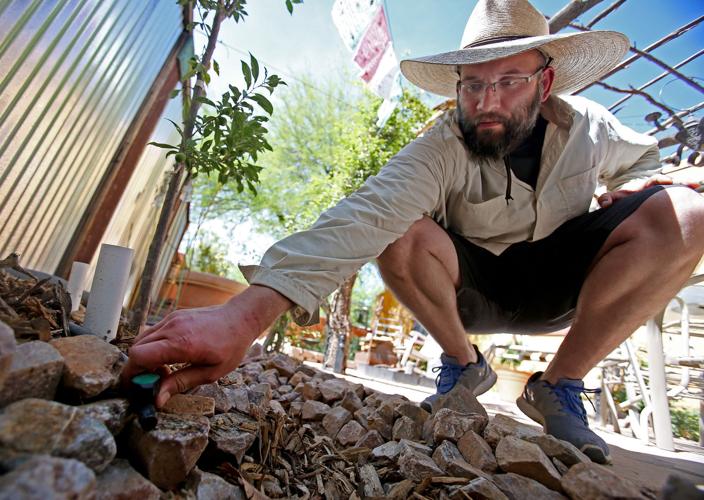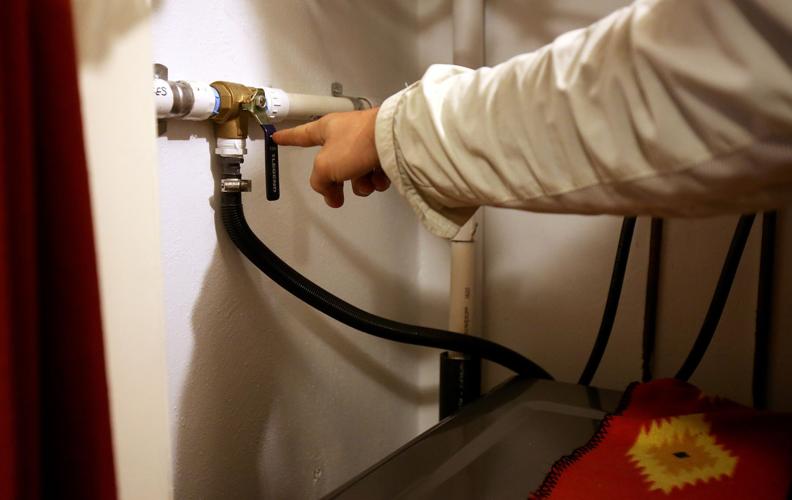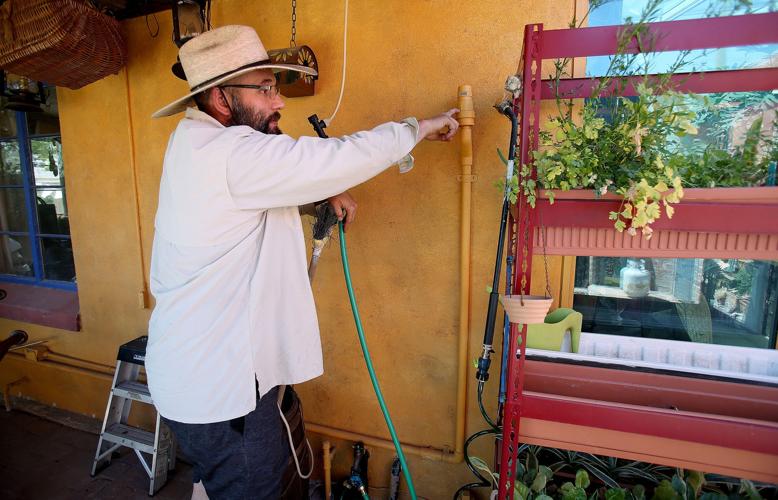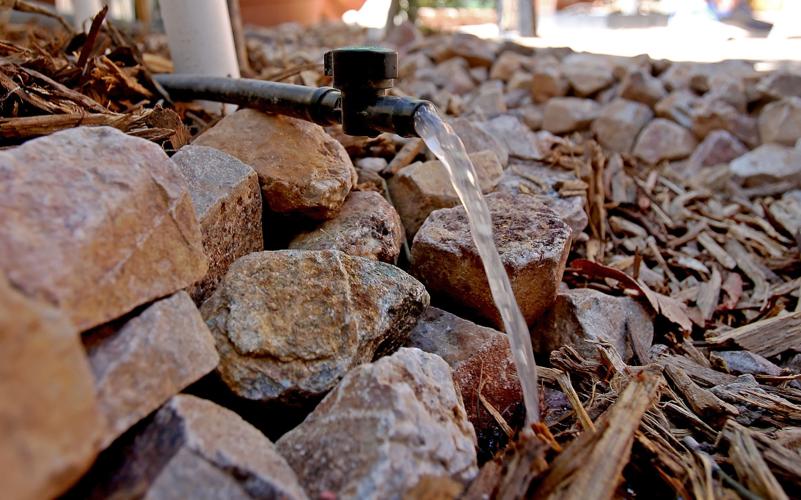If around two daily showers are taken at your house, you can grow a citrus tree.
Or, depending on how old your washing machine is, you can have a citrus tree if you wash between three to nine loads a week.
That’s how much water you use each year that you can use again to water a citrus tree. (For numbers crunchers: 17 gallons per shower or 20 to 50 gallons per laundry load divided into 9,000 gallons to water a citrus tree.)
Reusing water this way is called graywater — often spelled “greywater” — harvesting.
“It’s any water that’s been used once that is clean enough to use again,” explains Lincoln Perino, a project manager and designer for Watershed Management Group Inc. He’s responsible for teaching people about graywater harvesting and helping them design and install systems.
systems
Graywater harvesting can be as easy as running a hose from a washing machine to a place in the landscape that needs water, says Perino.
Homeowner Chris Wendel uses a pump and hose to send bath water out the window into a barrel. Then he uses that water for the landscape around the midtown home he owns with his wife, Wendy.
Midtown resident Darren Modzelewski says he considered using buckets to move water from the sinks and shower to the landscape.
Homeowners can qualify for rebates from Tucson Water if they install a permanent system. Perino, who had owned Ethos Rainwater Harvesting LLC, built one six years ago for the Wendels. He used four-inch pipes to send water from the washing machine and the shower outside to water trees and a vine.
Watershed Management built a similar system in October for Modzelewski’s home, which his mother, Susan, owns and also lives in. The graywater feeds native grasses and seven fruit trees.
Permanent systems include plumbing that sends water to the landscape and valves that allow users to send water to the sewer system instead. That’s done when the water has high concentrations of oil, grease or infectious material, such as from diapers .
If water needs to be pushed uphill into the landscape, pumps will be required. Some systems can include filters to clean contaminated graywater before use. Some can include holding tanks so that water can be stored until needed.
The most complete system would pipe sinks, bathtubs, showers, toilets, washing machines and dishwashers.
In reality, Perino says, people start with the easiest systems, those from washing machines and showers that use gravity to send water into the landscape. Because these home features typically are located on exterior walls, it’s simple to cut a hole through the wall to lay pipe into the landscape and to connect to the sewer pipe.
Those are the systems that both the Modzelewskis and the Wendels have.
Homes built in Tucson after 2010 are required to have the plumbing already in place for a graywater system.
RULES
The Arizona Department of Environmental Quality has guidelines for using graywater without requiring a permit, Perino says. They include:
- avoiding human contact with graywater.
- keeping graywater on your property.
- keeping graywater out of a wash or drainage way.
- assuring that ground water is at least five feet below the surface where graywater will be used.
- minimizing surface pooling.
- using only drip or flood irrigation, not spray.
- using graywater only for irrigation.
Under the rules, all plants grown for food can be irrigated with graywater, but surface irrigation is allowed only for citrus and nut trees.
COSTS
Tucson’s rebate program covers half the cost, up to $1,000, of installing a graywater system. That helps to reduce the up-front costs that vary depending on the complexity of the system, says Perino.
“The financial incentives made the system possible for us,” says Darren Modzelewski.
He says that he has seen their water costs go down, although they also save water with a rainwater harvesting system. Their sewer costs also have dropped because it is tied to water use.
Wendel, who also harvests rainwater, admits he’s used the saved water to increase irrigation to the yard. That practice doesn’t affect his water bill. “I would say I’m breaking even, but I’ve got a beautiful yard,” he says.
Perino says he often hears concerns about the cost of using eco-friendly cleaning products for graywater.
“Using different soaps tends to be a big hang-up for people,” he says. Beyond the issue of chemicals that can harm plants, some products contain a kind of salt that in high concentrations can kill plants.
Even biodegradable products could have this salt, while some regular hair products might have a sulfate that could actually make plants happy.
Plus, there are landscape plants that can tolerant high-salt soil.
Both the Wendels and Modzelewskis use biodegradable, low-salt, Oasis-brand soap for their laundry. Because it’s concentrated, a little goes a long way. “The per unit cost actually goes down,” says Darren Modzelewski.
The Modzelewskis use easily available castile soap for showering.
MAINTENANCE
Concerns about high-salt content in the water can easily be solved by flushing graywater-irrigated ground with city or rain water, Perino says.
Wendel says the only maintenance he’s had to do is clean out hair from the shower outflow pipe about once a week. The Modzelewskis haven’t had to do any maintenance on their months-old system.
SATISFACTION
Susan Modzelewski feels good about reducing her water use as a way to save the aquifer. “Every drop that you reuse is one that you’re saving,” she says.
“There’s your psychological benefit. You really feel like you’re doing something, helping the environment. You feel like you’re being responsible.”







